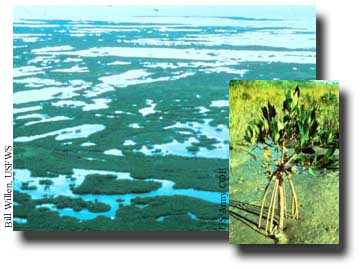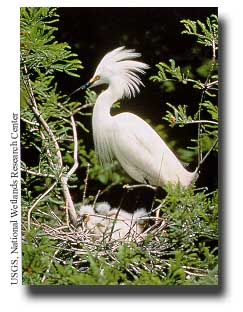Mangrove Swamps

Description
Mangrove swamps are coastal wetlands found in tropical and subtropical regions. They are characterized by halophytic (salt loving) trees, shrubs and other plants growing in brackish to saline tidal waters. These wetlands are often found in estuaries, where fresh water meets salt water and are infamous for their impenetrable maze of woody vegetation. In North America, they are found from the southern tip of Florida along the Gulf Coast to Texas. Florida's southwest coast supports one of the largest mangrove swamps in the world.

Mangrove trees dominate this wetland ecosystem due to their ability to survive in both salt and fresh water. In the continental United States, only three species of mangrove grow: red, black, and white mangroves. Red Mangrove (Rhizophera mangle) is easily recognized by its distinctive arching roots. Black Mangrove (Avicennia sp.), which often grows more inland, has root projections called pneumatophores, which help to supply the plant with air in submerged soils. White Mangroves (Laguncularia racemosa) often grow even farther inland with no outstanding root structures.

A wide diversity of animals are found in mangrove swamps. Since these estuarine swamps are constantly replenished with nutrients transported by fresh water runoff from the land and flushed by the ebb and flow of the tides, they support a bursting population of bacteria and other decomposers and filter feeders. These ecosystems sustain billions of worms, protozoa, barnacles (Balanus spp.), oysters (Crassostrea spp.), and other invertebrates. These organisms in turn feed fish and shrimp, which support wading birds, pelicans, and the endangered Crocodile.
